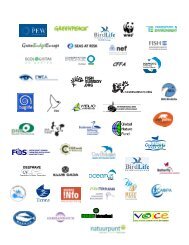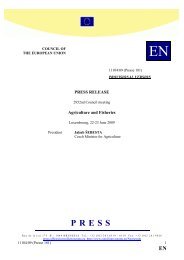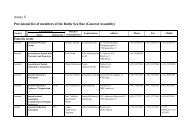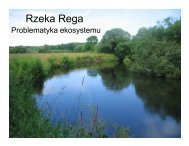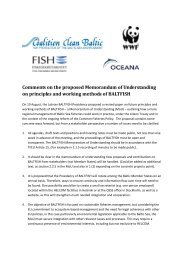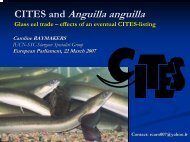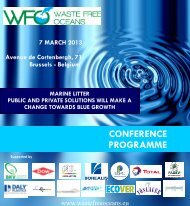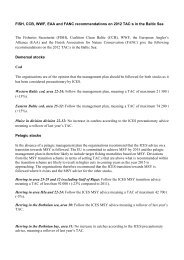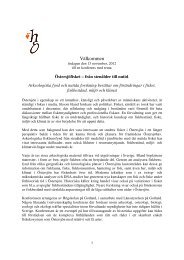A report on iUU fishing of Baltic Sea cod - Fisheries Secretariat
A report on iUU fishing of Baltic Sea cod - Fisheries Secretariat
A report on iUU fishing of Baltic Sea cod - Fisheries Secretariat
You also want an ePaper? Increase the reach of your titles
YUMPU automatically turns print PDFs into web optimized ePapers that Google loves.
which it has undermined their ability to providescientific advice.Also, the fact that nati<strong>on</strong>al experts and advisorsare not willing to go public, because they mightloose their jobs, c<strong>on</strong>firms the highly politicalnature <strong>of</strong> <strong>Baltic</strong> <strong>Sea</strong> fisheries management and,more specifically, IUU <strong>fishing</strong>.There is a danger that c<strong>on</strong>tinuing to attempt toaccount for mis<str<strong>on</strong>g>report</str<strong>on</strong>g>ing will c<strong>on</strong>tribute to a declinein the quality <strong>of</strong> the data and, therefore, inthe quality <strong>of</strong> the resulting stock assessment. Inadditi<strong>on</strong>, accounting for mis<str<strong>on</strong>g>report</str<strong>on</strong>g>ing in the assessmentcould also create incentives for furthermis<str<strong>on</strong>g>report</str<strong>on</strong>g>ing, as a higher estimated catch is likelyto lead to a higher estimate <strong>of</strong> stock size and thusincreased catching opportunities in the future.The Working Group has provided estimates <strong>of</strong>unallocated quota since 1993. The c<strong>on</strong>tinuedneed to do so and the apparent stability in itsestimates over the last 5 years suggests that <strong>Baltic</strong>States are unable, unwilling or not seriouslycommitted to effectively reducing the IUU <strong>fishing</strong>problem.Worldwide Fund for Nature (WWF) <str<strong>on</strong>g>report</str<strong>on</strong>g>The WWF European Policy Office commissi<strong>on</strong>eda <str<strong>on</strong>g>report</str<strong>on</strong>g> <strong>on</strong> IUU <strong>fishing</strong> in the Polish <strong>Baltic</strong> <strong>Sea</strong><strong>cod</strong> fishery in 2005. WWF chose not to publishthe <str<strong>on</strong>g>report</str<strong>on</strong>g> but allowed access to it for the purpose<strong>of</strong> this project. Poland was chosen as thefocus owing to comm<strong>on</strong> and c<strong>on</strong>sistent allegati<strong>on</strong>s,made by people within or associated withthe <strong>Baltic</strong> <strong>Sea</strong> <strong>cod</strong> <strong>fishing</strong> industry, <strong>of</strong> n<strong>on</strong>-complianceby the Polish <strong>cod</strong> fleet.Having spoken with the authors, the <str<strong>on</strong>g>report</str<strong>on</strong>g> providedthem with a significant challenge, primarilydue to difficulties in gathering credible andsubstantiated evidence. Despite this, the <str<strong>on</strong>g>report</str<strong>on</strong>g>highlights two pieces <strong>of</strong> work, <strong>on</strong>e <strong>of</strong> which isreferenced, which provide additi<strong>on</strong>al insight intothe potential IUU problem.The Marine Institute in Gydnia, Poland, producesa quarterly publicati<strong>on</strong> called “WiadomosciRybackie” (<strong>Fisheries</strong> News) which is aimedat the <strong>fishing</strong> industry and those with an interestin the <strong>fishing</strong> industry. In the March-April 2005editi<strong>on</strong> 4 , an article compares import and exportfigures for <strong>cod</strong> and <strong>cod</strong> products with <str<strong>on</strong>g>report</str<strong>on</strong>g>edlanding and nati<strong>on</strong>al c<strong>on</strong>sumpti<strong>on</strong> figures. Theresults show a discrepancy in export figuresequivalent to 49,000 t<strong>on</strong>nes <strong>of</strong> whole <strong>cod</strong>.The inference is that this discrepancy was causedby un<str<strong>on</strong>g>report</str<strong>on</strong>g>ed landings which, if it were true,would be over 3 times the <str<strong>on</strong>g>report</str<strong>on</strong>g>ed nati<strong>on</strong>al annuallandings. Table 3 below shows the figuresthat appear in the article. The WWF <str<strong>on</strong>g>report</str<strong>on</strong>g> attemptedto analyse import and export data butfound that detailed informati<strong>on</strong> <strong>on</strong> whole <strong>cod</strong> or<strong>cod</strong> products was difficult to obtain. The <str<strong>on</strong>g>report</str<strong>on</strong>g>recommends that further informati<strong>on</strong> needs tobe gathered before a definite c<strong>on</strong>clusi<strong>on</strong> can bedrawn.The un-referenced work that was menti<strong>on</strong>edrefers to a study carried out by the Swedish <strong>fishing</strong>industry in 2002. Using n<strong>on</strong>-scientific comparis<strong>on</strong>between like-for-like <strong>fishing</strong> vessels andinformati<strong>on</strong> <strong>on</strong> working practices provided byPolish crew working aboard Swedish and Danish<strong>fishing</strong> vessels, the study speculates that in 2003all the <strong>Baltic</strong> States and Russia could potentiallyhave exceeded their combined quota by as muchas 4 times, and that Poland could have exceededit by as much as 8 times. This would suggest anunbelievable and unrealistic figure in excess <strong>of</strong>350,000 t<strong>on</strong>nes.Table 3. Showing the <str<strong>on</strong>g>report</str<strong>on</strong>g>ed import, export, landing and nati<strong>on</strong>alc<strong>on</strong>sumpti<strong>on</strong> figures <strong>of</strong> <strong>cod</strong> for Poland in 2003Reported Figures for 2003Reported landings <strong>of</strong> <strong>cod</strong>Imported quantities <strong>of</strong> <strong>cod</strong>Polish nati<strong>on</strong>al c<strong>on</strong>sumpti<strong>on</strong> <strong>of</strong> <strong>cod</strong>Exported quantities <strong>of</strong> processed <strong>cod</strong>(Estimated live weight equivalent)DifferenceComment and analysis5,100 t<strong>on</strong>nes8,000 t<strong>on</strong>nes18,000 t<strong>on</strong>nes23,000 t<strong>on</strong>nes65,000 t<strong>on</strong>nes49,000 t<strong>on</strong>nesThe <str<strong>on</strong>g>report</str<strong>on</strong>g> provides a wide-ranging estimate<strong>of</strong> the levels <strong>of</strong> un<str<strong>on</strong>g>report</str<strong>on</strong>g>ed <strong>cod</strong> landings, whichserves to show the difficulties in accurately estimatingthe scale <strong>of</strong> the problem. The analysis <strong>of</strong><strong>of</strong>ficial statistics is c<strong>on</strong>sidered to be a good way<strong>of</strong> highlighting discrepancies; indeed, this is usedto inform some <strong>of</strong> the ICES estimates. However,uncertainty as to which sources <strong>of</strong> informati<strong>on</strong>are likely to be the most appropriate and calculating“whole <strong>cod</strong> equivalent” from the variety <strong>of</strong><strong>cod</strong> products (e.g., frozen filets, steaks, etc.) aretwo significant problems with this approach.– 12 –



